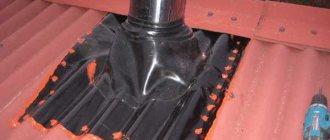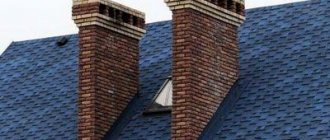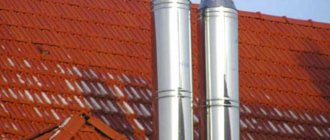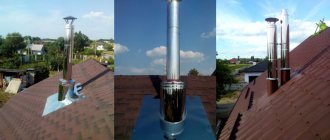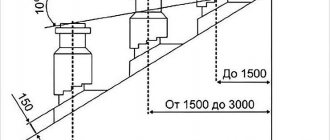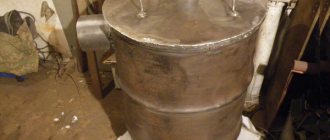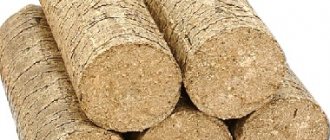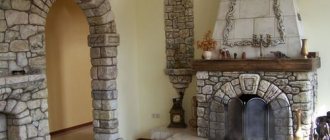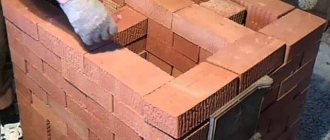- Why is a chimney pipe cap needed?
- Types of chimney caps
- How to choose and buy a chimney cap
- What types of chimneys are there depending on their shape?
- Which chimney pipe cap to buy, taking into account the structure of the pipe
- Do-it-yourself chimney deflector: drawings and photos
- Chimneys for brick pipes and forged chimney caps: features and prices
- Video: DIY chimney cap
We often see beautiful and unusual caps that home owners place over chimneys. At first glance, it seems that they perform only a decorative role, but they have functions that are very important when it comes to the safety of the chimney system. Let's consider why a chimney cap , on what principle it is selected, what types of designs exist and how to make it yourself.
The cap on the chimney pipe gives the roof originality and the chimney completeness.
Why is a chimney pipe cap needed?
Caps on the chimney pipe are a fairly common occurrence. However, many people are confused about what they are needed for. There is an opinion that they protect the pipe from condensation. However, this is not quite true. Evaporation and collection of moisture occurs in the inside of the pipe, and a cap on the chimney pipe (photos on the Internet clearly demonstrate the principle of its operation) can do little to help here.
What is a chimney pipe cap actually needed for? Let's look at a few of its main functions:
- protection of the inside of the pipe from various foreign objects, dust and debris;
- extending the operational life of the pipe by protecting it from precipitation;
- some caps, due to their design, increase the draft in the pipe and do not allow strong winds to overturn it;
- perform an aesthetic function, giving the pipe an attractive appearance.
A forged chimney cap gives an aesthetic appearance to the outer part of the chimney.
It is worth recognizing that most of the decorative vanes on the chimney pipe do not improve the functional characteristics of the chimney at all, but, on the contrary, reduce these indicators. The only exceptions to this rule are nozzles that have the following types of design:
- Weather vanes-deflectors.
- Nozzles with similar industrial exhaust deflectors.
The first option is much more effective than the second. The semi-cylindrical body remains movable due to the bearing. It can rotate depending on weather conditions, and like the petal of a weather vane, it is fixed so that its back is always turned to the wind. As a result, smoke draft increases due to the vacuum generated inside.
The principle of operation of the second mechanism is as follows: a certain vacuum appears inside the deflector itself, due to the fact that the air flow formed as a result of wind load goes around the head on the brick chimney pipe. As a result, such an “umbrella” functions differently, depending on weather conditions: in windy weather it increases traction, and in calm weather, on the contrary, it reduces it.
Stainless steel chimney weather vane.
On a note! A strong argument in favor of the first option is that the design of the chimney pipe completely eliminates the danger of the draft being blown out by the wind, which still sometimes happens when using the second type of system.
Deflector manufacturing process
To make it you will need a sheet of galvanized metal. The tools you will need are metal scissors, a ruler, a scriber, a drill and a device for joining materials with rivets.
First of all, you need to make a drawing of the necessary parts on metal.
Diffuser
- To make it, you need to calculate one template, with which you can create a drawing of the diffuser in expanded form with the correct angle of curvature. To do this, use the formula p=2πR. To calculate, take the diameter of the wide part of the diffuser and multiply the value by 3.14. The resulting figure should be divided by 10. The resulting value will be one side of the template.
- Perform the same calculations with the narrow part of the diffuser. Next, use the table and take the height of the diffuser from it, then transfer the obtained data to a galvanized sheet. This template is one tenth of the required drawing. By applying the template to each other 10 times (we did not divide the value obtained during the calculation above by 10), and drawing lines, you can create the correct drawing of this part. Don't forget to add 20mm around the edge for connection.
- After which it must be cut out using metal scissors.
When cutting metal, sharp edges are created. To prevent injury, wear gloves and goggles.
- Connect the edges of the product with a 10 mm overlap, drill holes and secure the edges with rivets.
After all the manipulations, the most complex part was obtained - the diffuser. But the calculation of the collet deflector is not yet complete.
Ring
- According to the terms of the drawing, two diameters of the air channel = ring diameter. Then you should calculate the circumference using the familiar formula p=2πR and add 20 mm for the connection. This will be the length of the workpiece.
- According to the condition, the width of the ring is 1.2 d. To calculate, the diameter of the air channel should be multiplied by 1.2. The resulting value will be the width of the ring.
- Transfer the obtained values to a galvanized sheet and cut out the workpiece. After which it must be bent into the shape of a ring. For fastening, make an overlap of 10 mm on each side.
- Drill holes and secure the ends of the workpiece with rivets.
Umbrella
First of all, you need to draw a circle on a galvanized sheet. Since critical dimensions are not given in the drawing, it should be made so that its diameter is 1.7-1.9d. Transfer the diameter of the ring to the metal, and draw two radii from the center of the circle so that the angle between them is 30°. Cut out this segment and connect the edges so that you get a cone with a diameter value in the range of 1.7-1.9d. Secure the edges with rivets.
A properly designed ventilation system provides clean and fresh indoor air. The main condition for its effective operation is the presence of traction. Unfortunately, debris and dust entering the channels can disrupt the normal operation of the equipment. To prevent this from happening, a deflector must be installed on the ventilation pipe.
If there is no deflector on the ventilation pipe, then its diameter will gradually decrease. This is most facilitated by the fat that accumulates on the walls of the air duct. This is where dust and debris sticks.
The ventilation deflector is installed on the head of the pipe. At first glance, this protects the channels from debris that may enter from the outside. But it's not that simple. The device performs a number of functions, each of which is important.
Types of chimney caps
In addition to the designs already discussed, there are many others that are also widespread. All of them are united by a common principle of operation and device - these are devices that serve to cover the cut of the pipe, while leaving a small gap so that combustion products can exit the pipe to the outside. The shape of the deflector on the chimney pipe can be almost any, but according to the material of manufacture they can be divided into several groups:
- made of galvanized (roofing) steel;
- made of galvanized metal, on top of which a polyester powder coating is applied;
- stainless steel;
- copper;
- alloyed from titanium and zinc.
Copper chimney cap.
If we talk about making a cap with your own hands, then most often they use galvanized steel with a thickness of about 0.8 mm. This option is most preferable due to its availability, as well as a fairly long service life (about 20 years). To better understand the design of such a chimney cap, photos and diagrams will serve as an excellent guide.
Galvanized steel has only one serious drawback - it quickly loses its original appearance and becomes dull. She is exposed to various external factors that have a negative impact on her. Metal that is additionally powder coated can withstand this impact much better, but such material is much more expensive.
All other metals retain their appearance for a long time, but their cost is several times higher. However, the price is reflected not only in their appearance, but also in their service life. And although copper also tends to tarnish over time, here we are talking about decades rather than years.
Chimney caps made of galvanized (roofing) steel.
The most popular types of deflectors
Modern deflectors are:
- With a flat pommel;
- With opening lid;
- With a gable roof - two slopes on a pipe;
- With a semicircular pommel.
Deflectors with a flat copper top are often installed on houses built in the Art Nouveau style. But for modern buildings, a cap with a semicircular top is more suitable. With a gable roof, they best protect the chimney from snow.
Basically, deflectors are made from sheets of galvanized iron, although recently you can increasingly see on sale deflectors in which the metal is coated with enamel or even a layer of plastic.
Go ahead. There are many deflector designs used in our country:
- TsAGI deflector;
- "Smoke tooth";
- Grigorovich deflector;
- Ball-shaped deflector with rotation;
- Open Astato;
- Round deflector "Voller";
- Star "Shenard".
The most common today is the TsAGI deflector. Let's look at its structure:
- Inlet pipe;
- Diffuser;
- Deflector housing;
- Brackets;
- Umbrella.
The domestic model of the “Smoke Tooth” deflector is also popular today. You need to insert it with the door facing the smoke collector. It looks like this: we place one edge on the wall, lift the second and lower it into place. For easy installation, remove the futerose plates from the back and side walls. You also see two handles in front of you - they are called “cold hand” and are designed to control and adjust the operation of the oven.
Have you chosen a model? Now let's look at how you can make a chimney deflector with your own hands - for your steam room.
How to choose and buy a chimney cap
Choosing a cap of the correct design is not an easy task. And first of all, it is worth considering the type of boiler house used and the type of fuel that is used. As an example, we can consider the fact that only nozzle-type nozzles are suitable for chimneys of gas boilers. They have an open top and are the only ones suitable for use in this case.
On a note! The installation of nozzles on pipes that provide smoke removal from gas boilers is regulated by regulations that prohibit the use of hoods for this type of chimney.
This ban has a completely logical justification: in winter, when the temperature drops below zero, the chimney cap is susceptible to freezing and may become covered with ice. Over time, ice can block most of the smoke exit opening, causing it to accumulate inside the structure. In this case, there is a serious danger to the health of the residents of the house, since smoke accumulating inside can cause serious poisoning.
Chimney system installation diagram.
Freezing occurs as a result of the formation of condensation, which appears on the surface of a cold metal upon contact with sufficiently warm combustion products. The situation is different only with solid fuel boilers. Due to the fact that its efficiency almost never exceeds 70-80%, the gas temperature accordingly remains within the range of 150-250°C. This is not dangerous and the use of the nozzle is completely acceptable.
On a note! Do not forget that if you use solid fuel, the cap will very quickly become covered with black soot. So you should not choose relief models that are too complex and cannot be cleaned.
Functionality and varieties
A cap, with which the chimney will be maximally protected, is also necessary to protect the chimney from rain, protect the chimney from water, and also with its help the following indicators are improved:
- Traction increases;
- The gas exhaust channels are reliably protected from debris and birds getting into them;
- The chimney pipe, if protected, retains its strength and becomes more durable and not prone to destruction;
- Thus, a rather attractive appearance of the hood is created.
The main components of any cap are the presence of the base itself and the lid, which is specifically designed to remove moisture, thus ensuring complete protection of the chimney from snow, rain, freezing and excessive condensation.
If there are two chimneys installed side by side on the roof of your house, under no circumstances use one common cap for them, as this will lead to disruption of the draft and a number of other problems. Cover each chimney with a separate cap, the distance between them should be about 400-600 millimeters.
When choosing or assembling your own protection for the chimney of a stove, fireplace or heating boiler, you must choose only high-quality fittings made from the right and suitable materials, which include stainless steel, aluminum, galvanized steel. You can also make or buy a copper cap, which is distinguished by its high strength and durability; also, as an addition, you can equip the cap with a special fine mesh and special heat-reflecting shields.
Chimney protection is an integral functional and decorative element of any chimney hood and the entire house as a whole; it is with the help of such a design that you can recreate and complement any image, design and decoration of a garden or building.
A major role in the selection and design is played by the shape of such a protective element, which can be:
- Flat;
- To be supplemented with a weather vane;
- Having a hipped roof;
- Equipped with a lid that can be opened.
What types of chimneys are there depending on their shape?
The variety of shapes of modern chimneys is very large. Here you can find almost any options. Let's look at the most popular of them, which have an unusual geometric shape and can decorate any pipe:
- a weather vane of a standard shape: it looks like a house with a hipped roof;
- chimney in the Art Nouveau style: designed like a standard one, but additionally has a flat top;
- European style chimney: has an unusual appearance due to the semicircular top;
- caps with a gable roof, which has four slopes (a very functional design that is well ventilated and at the same time protects the pipe from snow);
Cap with gable roof.
- weather vane with weather vane;
- weather vane equipped with a detachable lid.
Wind vanes with a weather vane are distinguished by the fact that a special damper is located inside the structure, allowing combustion products to calmly exit the chimney even in the windiest weather. And an additional opening lid provides easy access to the chimney channels for cleaning.
Depending on the shape, chimney roofs are divided into the following categories:
- tent;
- gable;
- hipped;
- semi-cylindrical (or vaulted);
- flat;
- spire-shaped;
- four-pincer.
However, in most cases, this parameter does not affect the functionality of the device and serves solely for aesthetic purposes, providing the chimney pipe with a unique appearance.
The chimney is an important element of the smoke removal system in the house.
Chimney deflector: what designs are there + how to build a simple version yourself?
Have you ever noticed a special cap over the chimney on your neighbors' roof? This is a deflector. Literally translated, this word means “reflector.” In fact, the deflector is a short pipe, a shell, which is usually mounted on a head with an umbrella and is designed to protect the upper section of the chimney from strong winds. The deflector on the chimney is also called a chimney or a weather vane - this is an ancient architectural element. Some of its variants remain true works of art to this day. Why not decorate your steam room with it?
Which chimney pipe cap to buy, taking into account the structure of the pipe
Another parameter that you should focus on when choosing a cap is the structure of the chimney. The ideal option is considered to be a three-layer structure made of modular sandwich panels. In this case, there is simply no need to protect the chimney from precipitation. All moisture that gets inside does not have a negative effect on the pipe, but, on the contrary, is beneficial, cleaning the pipe and collecting in the condensate collector.
If we are talking about a gas boiler, then there are no other options except a nozzle. But if you are dealing with a solid fuel system, then there are many options, although the most popular and functionally justified is the weather vane deflector. The beauty of such chimney vents is demonstrated by photos that are offered in large numbers on the Internet.
Many questions arise when it comes to arranging a brick pipe. There are no contraindications here if you are dealing with a solid fuel system. In this case, you can choose any cap you like. But if a gas system is used, then installing an umbrella on the chimney pipe is prohibited in this case.
But here a completely logical question arises: what to do with the destructive power of moisture that eventually gets inside? For this case, special structures are provided that can completely cover the brick base of the pipe.
A brick chimney is a reliable and inexpensive solution.
Installation of a deflector with a wind protection device
The deflector with wind protection is mounted as follows:
- Two bearings and a vertical axis are fixed in the chimney at two levels;
- A semi-cylindrical screen, a weather vane and a roof of the structure are successively installed on the axis.
The operating principle of this type of system is as follows:
- When the wind direction changes, the weather vane rotates and pulls a curtain behind it, covering the chimney from the wind. As a result, smoke can escape from the leeward side of the chimney at any time.
- Air flows pass tangentially over the semi-cylindrical screen and pull smoke behind them, increasing draft in the system.
To increase the efficiency of the structure, it is necessary to periodically lubricate the deflector bearings, and in the cold season, also remove ice that forms in the structure due to condensation. Taking into account the last nuance, we can say that such a nozzle on the chimney pipe from the wind can effectively protect only those structures that are located in warm regions.
Do-it-yourself chimney deflector: drawings and photos
A do-it-yourself canopy for a chimney pipe is not uncommon, and many people try to make it. If you have a sheet of galvanized metal and available tools, you can save a lot of money on the purchase and installation of a deflector. To do this you will need the following:
- a drawing set, a fairly long ruler, as well as a tape measure and a marker;
- metal scissors, fastenings (drill screws with 15 mm press washer or rivet gun);
- drill with various drill bits;
- material for the cap (galvanized, aluminum or stainless steel) with a thickness of 0.3-0.5 mm;
- additional metal parts for making rigid fasteners.
In order to make a smoke hood for a chimney pipe with your own hands, you need to make the appropriate measurements, and then, guided by the drawing, you can start working.
Using metal scissors, you can make a smoke vane with your own hands. To do this, you need to cut out the parts of the required size. Then roll up the diffuser body and drill holes in the top and bottom so that once the rivets are secured, you have a solid structure. Do-it-yourself chimney cap drawings will help you assemble it correctly.
Ventilation deflector: types and characteristics of deflectors for pipes (read more)
Diagram of the deflector-vane device: D = 108 mm; B = 210 mm; H = 80 mm; R = 200 mm; H1 = 530 mm.
After this, you can begin making the upper cone. You can attach the paws directly to it (usually you need about 6 pieces).
Before you completely assemble the wind vane onto the pipe with your own hands, do not forget to fix the fasteners with which the diffuser will be connected to the lower cone of the structure. The same rivets can be used as fastening. In order to install the cap on the pipe, it is best to remove its upper part in order to place the cap on the studs or legs, and then install the entire structure back.
On a note! Do not neglect the quality of installation of the deflector on the pipe. Being under constant wind load, poor-quality fastenings will very soon lose their characteristics and the structure will fall apart.
Of course, a DIY fungus on a chimney pipe has no decorative value. Its design is primitive, but it can increase traction by 20-25%, and also protect the roof from accidental sparks. Using the drawings, you can make a cap for a chimney pipe with your own hands quite simply and at the same time spending a minimum of resources.
Pattern diagram for making a chimney for a chimney.
Characteristics of deflectors
Purpose
An umbrella is installed on the chimney to enhance draft by deflecting air flows. Deflectors of the correct design prevent atmospheric phenomena from entering the chimney - snow, slanting rain (see Chimney deflector).
The chimney canopy also prevents debris and birds from getting inside. To do this, a mesh is installed, which freely allows smoke to escape outside.
Main functions
Thus, the chimney canopy performs the following functions:
- increased traction;
- increase in the efficiency of the chimney pipe (up to 20%);
- protection from snow, rain, debris;
- obstacle to the destruction of the brickwork of the chimney.
Important! A chimney cap will provide good draft only when the chimney does not move straight, but has several turns.
Chimney cap design
- cover or umbrella;
- drip or outlet for water.
A cover or umbrella is designed to protect against atmospheric agents entering the chimney. A drip line or water outlet is designed to remove draining moisture from the top of the pipe, thereby reducing the formation of ice during the winter.
Materials used to make a weather vane
When planning to make a chimney cap with your own hands, you should use materials that are heat-resistant and corrosion-resistant. The specified characteristics have the following materials:
- galvanized iron;
- stainless steel;
- copper.
It is important to remember that chimney caps are located in hard-to-reach places. Based on this, it is necessary to choose a cap that is made of high-quality material and that, according to its characteristics, is resistant to various atmospheric phenomena. One of the most durable is a chimney cap made of copper.
Chimneys for brick pipes and forged chimney caps: features and prices
On the Internet you can find many tips on how to make a chimney cap with your own hands. However, not everyone wants to bother with this, and many prefer the opportunity to purchase a ready-made product.
Prices for chimney caps vary widely, and you can buy a chimney cap for a chimney starting from 700 rubles. At the same time, the simplest umbrella to buy for a chimney pipe will cost 300-400 rubles.
If you want to buy a deflector for a chimney pipe that can truly become a decoration of the roof, you will have to spend a lot of money. Forged chimneys cost from 7,000 rubles and above. The price of a chimney for brick pipes largely depends on its size, material of manufacture, as well as the complexity of the forged elements, which come in a wide variety. You can look at photos of forged chimneys on specialized websites.
A forged chimney cap will never deteriorate and will provide reliable protection for many years.
Another rather expensive, but very beautiful option is a smoke vane. It comes in a wide variety of shapes and sizes, and at the same time it perfectly replaces a simple umbrella on a chimney pipe. Many craftsmen believe that using drawings, it is quite possible to make a weather vane for a chimney with your own hands. However, this requires considerable skill. The cost of the finished version will cost from 5,000 rubles.
Depending on your preferences, you can buy a ready-made chimney cap or make your own chimney cap. In any case, it would be a good idea to look at photos of chimneys that are on sale to get a general idea of their variety and purpose.
How to make a cap with your own hands?
Despite the limited service life, it is recommended to make the caps from durable galvanized sheet steel. This is an easy job that anyone with a simple set of tools can do.
First you need to measure the diameter of the pipe head on which the protective cap will be attached. Depending on the chosen type of structure, you need to sketch out on paper a rough sketch of a weather vane - gable, conical or hip type.
It is necessary to adhere to the basic rules in arranging a protective element for the chimney:
- the upper part of the structure - an umbrella or a lid - should be 10 cm larger than the pipe so that it protrudes 5 cm on all sides;
- the distance between the head of the chimney pipe and the fungus must be at least 10 cm, otherwise it will be difficult for smoke and exhaust gases to escape;
- the slope of the walls of the fungus or lid should be at an angle of 30 to 45 degrees;
- the nozzle should fit easily onto the pipe head, so you need to leave a gap by adding another 3-4 mm to the sketch.
Algorithm for making a weather vane using the example of a simple conical design on narrow brackets:
- Before working with sheet metal, you need to make a template on cardboard at a 1:1 scale. A simple pyramidal design involves dividing the pattern into 4 identical triangles connected by vertices.
- With the letter “d” mark the height of each vertical side of the triangles, with the letter “B” - the length of their base.
- The drawing must allow for the distance between two of the four sides of the pyramid that will need to be connected.
- To connect the sides, you need to make additional sections with a bend up to 15 mm high, in which holes are drilled for installing rivets.
- At the base of all the triangles, you need to draw the sides corresponding to the shape of the rectangular chimney nozzle.
- Dotted lines must be used to mark the fold lines.
- The finished pattern should be attached to a sheet of galvanized or stainless steel and cut to shape using scissors or a metal knife.
- The blade must be carefully drawn along the fold lines on the cardboard to leave press marks on the metal sheet. The resulting lines will serve as a guide for the folds.
- Using a drill, you need to drill holes for rivets on both sides of the workpiece.
- The metal is bent using a special sheet bender to form a pyramid shape. The connected parts of the structure are fixed with rivets.
- The upper protective part is ready. Now you need to make brackets from metal plates and weld them to the fungus. A primer is applied to the welding site, and the cap is coated with anti-corrosion paint. The finished legs of the structure are attached to a metal base, which is pre-made from metal plates according to the diameter of the pipe head.
We recommend that you read: Use of corrugated stainless steel pipes for heating systems
Expert advice
Do not use galvanized steel that is too thin. For small products it is better to take a sheet with a thickness of 0.7-0.8 mm, for large ones - 1 mm.
Do not skimp on materials - in this case, quality plays a huge role in ensuring the durability of your product.
Standards according to GOST
Excerpts from current regulatory documents regarding the installation of a deflector on a pipe inform about the following:
- any nozzles on the smoke channel must be mounted in such a way that they do not block the path of fuel combustion products;
- on a flat roof, the mouth of the pipe should be placed above the fence;
There should be free space around the mouth of the pipe - on a roof with slopes, the chimney head must be located above the ridge, if the space between them is less than one and a half meters, or at the level of the ridge, when the gap from the pipe to the highest point of the roof varies within three meters;
- the deflector must not be installed in an area where an aerodynamic shadow is created due to neighboring buildings;
- the device body must be well ventilated regardless of the wind direction;
- rotating deflectors are not suitable for chimneys of stoves located in houses built in areas with cold winters;
- installation of a round deflector on a brick chimney involves the use of special transition pipes.
Chimney draft and protection
Often, chimney pipes have a traditional round cross-section, in this case it would be best to protect and supplement such a structure with fungi or caps, which are secured by means of special racks that are located on a base with a diameter that will be five millimeters larger than the tubular element itself.
Mushrooms are ideal for protecting chimneys, they are equally effective for various air flows in horizontal, vertical and angular directions. The air, which has already been heated, slides over the surface of the fungus, after which the smoke masses are picked up and raised, after which the maximum increase in draft occurs. At the same time, the wind that blows from below forms small wind currents and allows the smoke masses to move more slowly, and in order for the cap to be as useful and effective as possible, it is necessary that its diameter and cross-section be larger than the chimney itself.
The traction mechanism of any chimney of a fireplace stove has an unstable draft, which, under certain conditions of use, operation, and weather conditions, can either increase or decrease, or disappear altogether.
In order for the draft to always be full and high enough, there is a need to mount and install special weather vanes on the roof of the house, which are capable of turning in a certain direction depending on the direction and movement of the wind. At the same time, it is the wind vane that is necessary to protect against blowing into the pipe, while gases can be independently removed from the smoke channels.
A weather vane installed on the chimney also prevents wind, debris and precipitation from entering the room and impairing the operation of the traction mechanism.
Please note that the weather vane must be quite strong and reliable - this will allow it not to break and work fully even in strong winds and the formation of a large amount of ice in the winter season. Basically, high-quality weather vanes are made from strong, heat-resistant and durable materials that will withstand strong heat well and do not form rust or corrosion on their surface.
If your house is located in the northern region, and you use solid fuel for kindling, you must additionally equip the chimney with a deflector, which will become additional protection. Moreover, if the chimney is made of metal, it would be best to install a metal umbrella with a drip. For a brick chimney hood, it is best to install a cap with a mesh and a wide frame that can cover the entire surface of the flues, above the roof level.
Also, as an indispensable chimney protection, you can install a special chimney on the pipe, which is equipped with a reflector, which is responsible for:
- Strengthening traction work;
- Wind protection;
- Leaves, debris and birds will not be able to enter a chimney equipped with such protection.
The chimney can belong to one of two categories, which are distinguished by the way the lid is positioned, which in turn can be located in the upper part or simply in the masonry. The cover can have the shape of a semicircle and thus be fixed to the cap by means of fixing posts; such a covering element acts as a reliable protection of the chimney from destruction and extends its service life.
